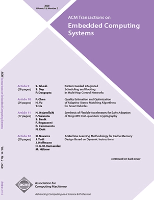
ACM Transactions on Embedded Computing Systems
Scope & Guideline
Advancing the frontier of embedded computing innovation.
Introduction
Aims and Scopes
- Embedded System Design and Optimization:
Research in this area focuses on methodologies for designing and optimizing embedded systems, including hardware-software co-design, energy-efficient architectures, and real-time scheduling. - Machine Learning and AI in Embedded Systems:
This scope encompasses the integration of machine learning and artificial intelligence techniques into embedded systems for applications such as edge computing, IoT, and smart devices. - Security and Privacy in Embedded Computing:
The journal emphasizes research on security protocols, hardware security mechanisms, and privacy-preserving techniques tailored for embedded systems. - Resource Management and Scheduling:
Papers in this area cover dynamic resource allocation, scheduling algorithms, and management frameworks for real-time and mixed-criticality systems. - Fault Tolerance and Reliability:
This focus includes methodologies for ensuring reliability in embedded systems, such as fault detection, recovery mechanisms, and system resilience. - Networking and Communication Protocols:
Research on communication protocols, network-on-chip designs, and efficient data transfer methods for embedded systems is also a significant aspect of the journal. - Energy Efficiency and Sustainability:
The journal promotes research aimed at enhancing energy efficiency in embedded systems, including low-power design techniques and sustainable computing practices.
Trending and Emerging
- Integration of AI and Machine Learning:
There is a significant increase in research integrating AI and machine learning into embedded systems, focusing on applications like real-time inference, adaptive learning, and intelligent decision-making. - Energy-efficient Computing:
Research on energy-efficient designs, particularly for edge computing and IoT applications, is gaining traction as the demand for sustainable technologies grows. - Post-Quantum Cryptography:
As concerns about the security of existing cryptographic methods grow, there is an emerging focus on post-quantum cryptographic techniques specifically tailored for embedded systems. - Tiny Machine Learning (TinyML):
The trend towards TinyML highlights the development of machine learning algorithms that can run on resource-constrained devices, enabling real-time data processing and decision-making. - Cyber-Physical Systems (CPS) and Internet of Things (IoT):
Research on CPS and IoT continues to grow, emphasizing the need for reliable, secure, and efficient systems that can operate in interconnected environments. - Real-time Processing and Edge Computing:
The emergence of edge computing paradigms is reflected in the growing research on real-time processing capabilities for embedded systems, allowing for low-latency applications. - Advanced Security Techniques:
There is a noticeable trend towards more sophisticated security techniques that address vulnerabilities in embedded systems, including hardware-based security measures and secure communication protocols.
Declining or Waning
- Traditional Embedded Systems without AI Integration:
Research focusing solely on conventional embedded systems without the integration of AI or machine learning techniques is becoming less prevalent as the field shifts towards smart and adaptive systems. - Legacy Communication Protocols:
Papers centered on older or less efficient communication protocols are decreasing, as newer protocols that offer better performance and security are taking precedence. - Hardware-centric Designs without Software Considerations:
There is a noticeable decrease in research that purely focuses on hardware designs without considering the software implications, as the trend moves towards more holistic approaches that integrate both aspects. - Static Resource Management Techniques:
Static resource management strategies are being overshadowed by dynamic and adaptive approaches that better address the needs of modern, heterogeneous embedded systems. - Low-complexity Security Approaches:
Simple security measures that do not scale well with the increasing complexity of systems are being phased out in favor of more robust and scalable security frameworks.
Similar Journals

EURASIP Journal on Wireless Communications and Networking
Driving Progress in Communication and NetworkingThe EURASIP Journal on Wireless Communications and Networking, published by Springer, stands as a pivotal platform dedicated to advancing the field of wireless communications and networking. With an ISSN of 1687-1472 and E-ISSN of 1687-1499, this Open Access journal has been disseminating high-quality research since 2004, ensuring broad accessibility for scholars and professionals worldwide. Maintaining an esteemed position in the academic community, it is classified in the Q2 quartile for 2023 across critical categories including Computer Networks and Communications, Computer Science Applications, and Signal Processing. The journal's performance is reflected in its Scopus rankings, which place it in the 73rd percentile for Computer Networks and Communications and the 72nd percentile for both Computer Science Applications and Signal Processing. With a focus on innovative research and practical applications, the EURASIP Journal is an essential resource for anyone seeking to contribute to or stay informed in the dynamic landscape of wireless communication technology.
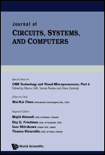
JOURNAL OF CIRCUITS SYSTEMS AND COMPUTERS
Driving Technological Advancement in Electrical EngineeringJOURNAL OF CIRCUITS SYSTEMS AND COMPUTERS is a pivotal publication in the fields of Electrical and Electronic Engineering as well as Hardware and Architecture, published by World Scientific Publishing Co. Pte Ltd in Singapore. With an ISSN of 0218-1266 and an E-ISSN of 1793-6454, this journal has contributed significantly to the discourse surrounding innovative research and technological advancements since its inception in the late 1990s. It currently holds a Q3 ranking in both relevant categories, reflecting its competitive stature and providing researchers, professionals, and students a substantial platform for disseminating findings. The journal covers a diverse range of topics, focusing on the design, analysis, and application of circuits, systems, and advanced computing technologies. Authors benefit from a rigorous peer-review process, ensuring high-quality publications that drive the field forward. The journal's commitment to excellence underscores its importance in fostering academic collaboration and knowledge exchange, making it a vital resource for anyone dedicated to advancing the domains of electrical engineering and computer science.
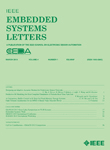
IEEE Embedded Systems Letters
Advancing Embedded Innovation, One Letter at a Time.IEEE Embedded Systems Letters is a prominent scholarly journal dedicated to advancing the field of embedded systems engineering, published by the IEEE - Institute of Electrical and Electronics Engineers. Since its inception in 2009, this journal has become an essential resource for researchers, practitioners, and students, offering a platform for the dissemination of innovative research and technological advancements in embedded systems. With an esteemed Q2 ranking in both Computer Science (miscellaneous) and Control and Systems Engineering, it ranks within the top half of the field, reflecting its impact and relevance. The journal covers a wide array of topics, including hardware-software co-design, real-time systems, and system-on-chip architectures, making it an invaluable reference for those engaged in the development of cutting-edge technologies. Subscribers benefit from exclusive access to rigorously vetted articles, conference reports, and reviews, contributing to the vibrant dialogue within the embedded systems community. With its commitment to excellence, IEEE Embedded Systems Letters serves as a critical avenue for fostering collaboration and innovation in this rapidly evolving domain.
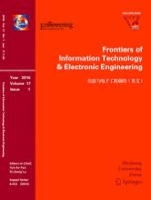
Frontiers of Information Technology & Electronic Engineering
Connecting Minds for a Technological FutureFrontiers of Information Technology & Electronic Engineering, published by Zhejiang University Press, is a leading academic journal dedicated to advancing the fields of information technology and electronic engineering. With an impressive impact factor and categorized in the Q2 quartile across multiple fields including Computer Networks and Communications, Electrical and Electronic Engineering, Hardware and Architecture, and Signal Processing, this journal serves as a crucial platform for researchers and practitioners to disseminate cutting-edge research and innovations. The journal, which operates under an Open Access model, ensures that high-quality research is accessible to a global audience, fostering collaboration and knowledge sharing within the scientific community. Based in Hangzhou, China, and in operation since 2015, it has rapidly established itself as a reputable source of scholarly articles, ranking in the top percentiles in its respective categories with commendable Scopus rankings. By bridging academic research and practical applications, Frontiers of Information Technology & Electronic Engineering plays a pivotal role in shaping the future of engineering and technology.
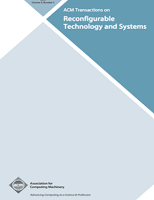
ACM Transactions on Reconfigurable Technology and Systems
Pioneering Innovations in Reconfigurable SystemsACM Transactions on Reconfigurable Technology and Systems is a leading journal in the field of computer science, specifically focusing on the rapidly evolving area of reconfigurable technology. Published by the esteemed Association for Computing Machinery, this journal provides a vital platform for researchers and practitioners to share groundbreaking findings and innovative methodologies that drive advancements in system design, architecture, and implementation. The journal boasts a commendable impact factor and has positioned itself within the top quartile (Q1) of computer science journals as of 2023, with a notable Scopus rank of #64 out of 232 in the General Computer Science category, placing it in the 72nd percentile. As a trusted resource for the latest developments from 2008 to 2024, the journal encourages submissions that challenge conventional approaches and propose novel solutions in reconfigurable technologies. Although it is not open access, it continues to strive for accessibility and dissemination of knowledge that is critical for academics, industry professionals, and students alike.
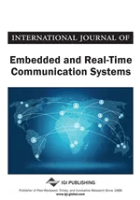
International Journal of Embedded and Real-Time Communication Systems (IJERTCS)
Exploring the Frontiers of Real-Time Communication TechnologiesInternational Journal of Embedded and Real-Time Communication Systems (IJERTCS), published by IGI Global, stands at the forefront of research in the domain of communication systems that operate on embedded and real-time frameworks. With its ISSN 1947-3176 and E-ISSN 1947-3184, this peer-reviewed journal has been a crucial platform for disseminating groundbreaking research and practical applications from 2010 to 2023. Although currently categorized in the Q4 quartile of computer science in Scopus, the journal offers unique insights into innovative communication strategies that bridge theoretical concepts with real-world implementation. Researchers, practitioners, and students alike rely on IJERTCS for comprehensive studies that address both contemporary challenges and future prospects in embedded systems. The journal enhances the academic discourse through highly relevant articles, supporting the development of robust communication technologies that are becoming increasingly vital in our interconnected world.
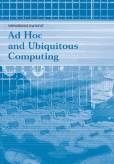
International Journal of Ad Hoc and Ubiquitous Computing
Empowering Knowledge in Computer CommunicationsThe International Journal of Ad Hoc and Ubiquitous Computing, published by InderScience Enterprises Ltd, is a premier platform dedicated to advancing the fields of computer networks, communication systems, hardware, and software architecture. Since its inception in 2005, this journal has served as a critical resource for researchers, professionals, and students aiming to explore the intricate dynamics of ubiquitous computing and ad hoc networks. Though currently not an open-access journal, its scholarly contributions are well-recognized, as evidenced by its rank in the Scopus database, which places it within the lower quartiles of its respective categories. With an increasing focus on innovative solutions in computer science, the journal aims to facilitate knowledge dissemination and encourage interdisciplinary collaborations. Researchers are particularly drawn to the journal for its comprehensive coverage of emerging technologies, making it an invaluable asset in a world increasingly reliant on sophisticated communication infrastructures. As it continues to thrive towards 2024, the journal remains committed to fostering a vibrant academic community.

Electronics
Illuminating the Path of Electronic InnovationElectronics, published by MDPI since 2012, stands as a pivotal open-access journal that caters to a wide spectrum of disciplines within the electrical and electronic engineering domain. With a strong commitment to disseminating innovative research, this journal has garnered notable recognition, achieving a Q2 ranking in multiple pertinent categories, including Computer Networks and Communications, Control and Systems Engineering, and Signal Processing. Its editorial standards and open-access format enhance the visibility and accessibility of high-quality research, making critical advancements in technology available to a global audience. Located in Switzerland, the journal is positioned to foster international collaboration and dialogue among researchers, professionals, and students dedicated to exploring the evolving landscape of electronics and its applications. With an E-ISSN of 2079-9292, the journal is meticulously indexed in reputable databases like Scopus, further solidifying its relevance and influence in the engineering community.
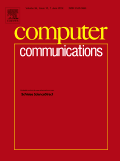
COMPUTER COMMUNICATIONS
Exploring Innovations in Computer NetworksCOMPUTER COMMUNICATIONS is a premier journal published by Elsevier, covering cutting-edge research in the field of computer networks and communications. With an impressive 2023 Scopus ranking placing it in the 95th percentile and classified as Q1 in its category, this journal embodies the forefront of technological advancement and scholarly excellence. Since its inception in 1978 and poised to continue until 2024, COMPUTER COMMUNICATIONS serves as an essential platform for disseminating high-impact research that advances our understanding of computer networking protocols, architectures, and applications. Although it is not an open-access publication, the journal provides various access options to ensure that its findings are widely circulated among researchers, professionals, and students. Through rigorous peer review and a commitment to fostering innovation, COMPUTER COMMUNICATIONS plays a vital role in shaping the future of communication technologies.

Journal of Grid Computing
Empowering Innovation in Grid TechnologiesThe Journal of Grid Computing, published by Springer, stands as a pivotal resource in the dynamic field of computer science, particularly within the realms of Computer Networks and Communications, Hardware and Architecture, Information Systems, and Software. With an impressive Q1 ranking across these categories in 2023, the journal exemplifies excellence and rigor, catering to a diverse readership from researchers to industry professionals. Established in 2003, this esteemed journal is anchored in the Netherlands and releases cutting-edge research that reflects trends and advancements in grid computing technologies. Researchers can gain insights through its vast contributions, while institutions benefit from its prestigious standing within the SCOPUS framework, boasting high percentile ranks in multiple computer science categories. Though not open access, the journal provides unparalleled access options for institutional subscribers, solidifying its importance as a gateway to innovative discoveries in high-performance distributed computing.